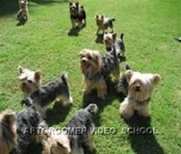 |
Dobermann
Other Names: Doberman Pinscher and Dobie Country of origin: Germany Dog Group Kennel Club: Working General appearance: Dobermans are medium to large sized dogs who can be be used as guard dogs but also make good pets. They have a compact and muscular body, a proud appearance and are also capable of going quickly. Dobermans also have a smooth and short haired coat. The coat of the Doberman Pinscher is thick, smooth, short, hard, and close-fitting. There are typically rust colored markings above the eyes, on the muzzle, throat, legs, feet, chest, and below the tail. This breed is an average shedder. This is a moderately large, powerful, yet still elegant animal. This dog appears to be square in the body, they are built for endurance and speed. Colours: The most common colour is black and tan but brown, blue and fawn variations do exist with tan markings. Size: Bitch 63cm - 68cm Weight: Min Max Bitch 32kg (71lbs) 45kg (99lbs)
Temperament: Dobermans are intelligent, alert and loyal and can be very obedient. They are bold but should not be vicious or aggressive in any way. Some people believe Dobermans to be vicious due to their use as guard dogs but in fact, this is not what the breed is like. They are known to be excellent in the family environment. They MUST be properly trained as a bored dog will develop behaviour problems and a big, strong dog, of any breed, must know where it belongs in the pack hierarchy. Socialised early with other dogs, pets and children, the Dobermann can make a lovely family pet. Movement: Elastic and balanced and capable of covering great distances. Care and training: Doberman Pinschers require minimal grooming. Occasional brushing or wiping of the coat with a damp cloth will minimize loose hair. Dental hygiene is crucial to prevent early tooth loss. Overall Exercise:2 hours per day Feeding requirements: Being a largish, deep-chested dog, Dobermanns can be prone to bloat and should not be fed within one hour of exercising. Two small meals per day are safer than one large meal, Puppies should be fed a highly nutritious diet for the first two years to ensure correct growth and development levels. Exercise: Med Grooming: Low Noise: Low Personal Protection: High Suitability As Guard Dog: High Level of Aggression: High Compatibility With Other Animals: Low Suitablity for Children: Medium Often docked? Yes Average litter size: 3-8
Life expectancy (yrs): 10 - 15 years.
History: The origins of the Doberman Pinscher come from Apolda in Thuringen, Germany in the 1870s. Louis Dobermann, a tax collector and local dog pound owner is credited with the creation of this breed. Dobermann needed protectors and intimidators on his tax collection rounds due to traveling in bad areas. Louis would take certain dogs with him, but he wanted to develop a breed that was hardy, intelligent, of sound temperament and had quick reactions. He also wanted a dog that was strong and had more of a guarding instinct. Within record timing, Dobermann created a breed from the German Shepherd, German Pinscher, Weimaraner, Rottweiler, English Greyhound and Manchester Terrier. This breed was called the Doberman, obviously due to his name. Most authorities feel they came from a shorthaired shepherd, the Rottweiler, a German smooth-haired Pinscher and a Black and Tan Terrier. At first, the breed was quite vicious and was said to attack "even the devil himself". They were difficult to keep, and courage was needed to own and train one. In America around that time, one Doberman won three Best in Show awards before the judges even looked at the teeth. When they finally examined his mouth, they discovered he had several missing teeth--a major fault in the Doberman. Today, the breed has been bred down to have a more cohesive personality and easier training capabilities. This is credited partly to Otto Goeller, who took over the breeding of the dogs after Dobermann's death. Goeller created the German National Doberman Pinscher Club in 1899, and the breed was given official recognition in 1900. Around WWI, America began to seek out this new breed, while in Germany the breed was lilting due to the war, and scarcity of food. In 1948 the breed gained a club in England, and soon after was given recognition by the British Kennel Club.
|
|
|
|
